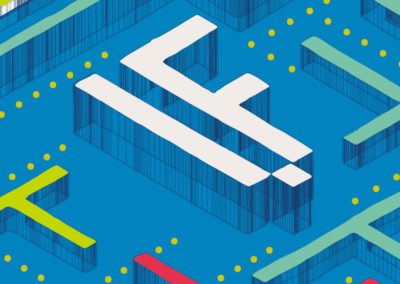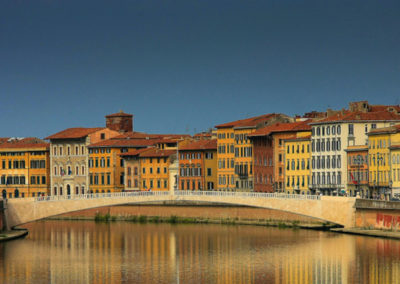Updates
LOCATION
Camera di Commercio
Palazzo Affari is home to the Pisa Chambers of Commerce. Built on the ruins of a former convent, it is built over seven floors, with a small inner open-air courtyard and a total area of about 14,000 square meters. The building was recently completely renovated and now acts as a fully equipped venue for trade fairs, exhibitions and conferences, with educational services and crèche for children, as well as hosting a range of activities. Flexible and welcoming, it is a perfect setting for many IF2017 events: panels, workshops and keynote speeches.
Cinema Arsenale
Opened on 20 January 1982 in the historic center of Pisa, the Cineclub Arsenale has always been conceived as a place to screen films that were impossible to find elsewhere. In 2014, it received the award for Best Cinema d'Essai from Agis-Fice, and each season the Arsenale screens over 220 films and holds themed reviews. Ever since the first edition of the Internet Festival, our collaboration with the Cineclub Arsenale team has allowed us to offer video events and discussions exploring the paths of digital innovation applied to production, creativity, distribution and the enjoyment of cinema.
Logge dei Banchi
The Logge dei Banchi is a loggia in Pisa, situated at the beginning of the Ponte di Mezzo bridge in the southern half of the city centre. The loggia, supported by twelve pillars, was built between 1603 and 1605 by architect Bernardo Buontalenti. At the time it housed the wool and silk market (the name "banchi" refers to the market stalls), and it continues to be used today for markets of various kinds. The headquarters of the State Archives of Pisa have been housed in the floor above the loggia since 1865. 20th century public baths are located in the basement, and have recently been reopened. During the Internet Festival, the loggia traditionally hosts the info point, various installations and the open space for the public of the Tuscany Region.
MixArt
During the Internet Festival, MixArt hosts the universe of games and their development. Set up in a renovated abandoned building, MixArt is a container of social and cultural innovation capable of connecting Pisa to the rest of the world. It is a multifaceted space where people, groups and associations can find a home. Sports, art and creativity all meet, with nearly 2000 members in more than 700 m² of rooms, used to host courses, workshops and events ranging from music to technology, circus to dance, and martial arts to theatre.
Lumiere
Lumière has its roots in the origins of cinema in Italy. It was officially born in December 1905 with the name "Primary Cinematographer Lumière". The initial site was in the billiard room of the Caffè dell'Ussero in Palazzo Agostini, on the Lungarno, where the first projections began in 1899. Later the entrance was moved to the back of the Palace, in the Vicolo dei Tidi, in the heart of the historic center of Pisa, where some ancient buildings originally comprising the church of Sant’Ilario in Porta Aurea stood. At Lumière, on October 19, 1906, the first film sound reinforcement experiment was carried out by professor Pietro Pierini of the University of Pisa. Damaged by city fighting during the Second World War, the restaurant was closed in 1944 and reopened in 1946 with the name of "Supercinema".
Scuola Normale Superiore
Palazzo della Carovana (or dei Cavalieri) is the main campus of the Scuola Normale Superiore. It was built between 1562 and 1564 by Giorgio Vasari, renovating the medieval Palazzo degli Anziani. It was named for the three-year apprenticeship during which new soldiers would be trained in the handling of weapons, before joining the "caravans" that would travel the Mediterranean and fight off pirate raids. The characteristic facade is designed by Vasari, blending architecture, sculpture and painting, animating the facade with graffiti of allegorical figures and zodiac signs by the architect himself, along with marble busts and coats of arms.
Centro Congressi le Benedettine
Internet Festival 2017 will be reopening the Monastery of St. Benedict, built in 1393 and a feature of one of the banks of the river in Pisa with its facade with flamboyant Gothic-style windows. The Benedettine in Lungarno complex was deconsecrated in the late 1960s, after which it was purchased and restored by private individuals, and is currently used by Pisa University. With its numerous classrooms, auditoriums, terraces, and arcades with a characteristic garden and a bright caveau, it is a charming yet functional and welcoming location for educational activities and events.
Officine Garibaldi
The Officine Garibaldi were built on the site of the Istituto Commerciale Einaudi, respecting its original volumes
and shape. The building is a multi-purpose structure, with a surface of almost 5 thousand m2 (plus a similar sized
outdoor space), with glass walls to enhance the ancient walls that stand behind it. It is used for a workspace,
co-working, training courses and events. The result is a centre where different generations and cultures can share
activities and develop business and project ideas.
Manifatture Digitali Cinema
The Manifatture Digitali Cinema (MDC) of Pisa are located in the historic buildings of the former Stallette, and offer
equipped and technologically advanced cineportual spaces. The project supporting the film production and audiovisual
sector is known as Mibact - funded by Dg Cinema, Territorial Cohesion Agency - Apq Sensi Contemporanei
Toscana per il Cinema, Tuscany Region, Fondazione Sistema Toscana, together with the Municipalities of Prato and
Pisa, which house the two locations.
Cittadella Galileiana - Museo degli Strumenti per il Calcolo
A journey into the history of calculus from the late-19th century arithmometres to the home computers of the
1980s, past the great calculators from which the Italian computer science adventure began. See this and more at
the Museum of Calculation Instruments, located in the Cittadella Galileiana area, a 12 thousand square meter park
in the heart of the city.
Cittadella Galileiana - GATE
GATE - Galileo Aggregator for Technology, inaugurated in May 2018, is the new urban ecosystem dedicated to innovation
and growth in the City of Pisa. The GATE project, led by Erre Quadro srl (a spin-off of the University of Pisa) and
the Giacomo Brodolini Foundation, is a new piece of the Cittadella Galileiana (Area Ex Macelli) which aims to create
a business aggregator with a strong thematic focus on digital technology, in order to encourage the development of
solutions able to respond to the challenges deriving from the paradigms of the Internet of Things and Industry 4.0.
Gipsoteca
The collection of the Gipsoteca of Ancient Art, among the first in Italy, began in 1887 on the initiative of Gherardo Ghirardini who was inspired by the Germanic archeology model. The collection now offers a synthesis of the most famous and significant works of Greek, Etruscan and Roman art, alongside lesser-known or unpublished specimens, and small plastic artefacts: faithful reproductions of ancient works preserved in different national and foreign museums, in some cases lost and, sometimes, particular versions fruit of historical restorations or reconstructions purposely realized in Pisa on the basis of new interpretative proposals. Today the Gipsoteca also houses the collection of the Antiquarium of classical archeology and the Palethnological Collections.
Ponte di Mezzo
The ‘Conte Ugolino’ bridge, known as the Mezzo, is a bridge crossing the Arno in Pisa. Ideally located in the centre of the city, it connects piazza Garibaldi, in the district of Tramontana, with piazza XX Settembre, in the district of Mezzogiorno, where you can find Palazzo Pretorio, the city hall and the Logge di Banchi.
Scuola Superiore Sant'Anna
The school’s headquarters are located in the rooms of the former convent of Sant’Anna, a Benedictine convent of
fourteenth-century origin, later suppressed in 1786 by Pietro Leopoldo di Lorena. This is the “heart” of the school,
surrounded by greenery and with an exclusive view onto the nineteenth-century Piazza Martiri della Libertà (better
known by the Pisans as Piazza Santa Caterina).


